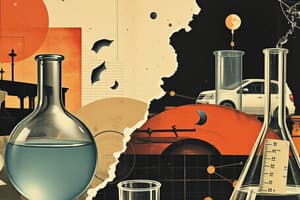Podcast
Questions and Answers
What is the study of the nature of matter called?
What is the study of the nature of matter called?
- Physics
- Chemistry (correct)
- Biology
- Geology
What occupies space and has weight?
What occupies space and has weight?
Matter
What is metabolism?
What is metabolism?
The combination of chemical reactions through which an organism builds up or breaks down materials
What is the pH scale?
What is the pH scale?
The pH scale ranges from ____ to ____.
The pH scale ranges from ____ to ____.
What is a pH level of 7 considered?
What is a pH level of 7 considered?
A pH less than 7 is considered to be an ____.
A pH less than 7 is considered to be an ____.
An acid has a high level of what type of ion?
An acid has a high level of what type of ion?
Give an example of an acid.
Give an example of an acid.
A base is considered to be ____.
A base is considered to be ____.
Give an example of a base.
Give an example of a base.
What are bases?
What are bases?
What is an element?
What is an element?
What is an atom?
What is an atom?
What charge does a proton carry?
What charge does a proton carry?
What charge does an electron carry?
What charge does an electron carry?
What is a neutron?
What is a neutron?
What is a solute?
What is a solute?
Give an example of a solute.
Give an example of a solute.
What is a solvent?
What is a solvent?
Give an example of a solvent.
Give an example of a solvent.
The solvent is usually a ____.
The solvent is usually a ____.
What is a suspension?
What is a suspension?
Give an example of a suspension.
Give an example of a suspension.
What does a buffer do?
What does a buffer do?
Carbohydrates contain ____.
Carbohydrates contain ____.
Proteins produce ____.
Proteins produce ____.
Proteins are formed from ____.
Proteins are formed from ____.
The 3 states of matter are ____.
The 3 states of matter are ____.
What is a solid?
What is a solid?
What is a liquid?
What is a liquid?
What is a gas?
What is a gas?
How do mixtures differ from compounds?
How do mixtures differ from compounds?
What are compounds?
What are compounds?
What are mixtures?
What are mixtures?
Name 5 characteristics of protoplasm which enable a cell to survive.
Name 5 characteristics of protoplasm which enable a cell to survive.
What is the symbol for Hydrogen?
What is the symbol for Hydrogen?
What is the symbol for Oxygen?
What is the symbol for Oxygen?
What is the symbol for Carbon?
What is the symbol for Carbon?
What is the symbol for Nitrogen?
What is the symbol for Nitrogen?
What is the symbol for Calcium?
What is the symbol for Calcium?
What is the symbol for Sodium?
What is the symbol for Sodium?
What is the symbol for Potassium?
What is the symbol for Potassium?
What is the symbol for Phosphorus?
What is the symbol for Phosphorus?
What is the symbol for Chlorine?
What is the symbol for Chlorine?
What is the symbol for Magnesium?
What is the symbol for Magnesium?
What is the symbol for Iron?
What is the symbol for Iron?
What is the symbol for Copper?
What is the symbol for Copper?
What is the symbol for Iodine?
What is the symbol for Iodine?
What is the symbol for Sulfur?
What is the symbol for Sulfur?
What are the 4 elements that make up protoplasm?
What are the 4 elements that make up protoplasm?
What are the composition and parts of an atom and their charges?
What are the composition and parts of an atom and their charges?
What are the types of reactions?
What are the types of reactions?
What is synthesis?
What is synthesis?
Flashcards are hidden until you start studying
Study Notes
Chemistry Basics
- Chemistry is the study of the nature of matter.
- Matter is anything that occupies space and has weight; it can be living or non-living.
Metabolism and pH
- Metabolism consists of chemical reactions that build up or break down materials in organisms.
- The pH scale measures acidity or alkalinity, ranging from 1 to 14.
- A pH level of 7 is neutral.
- A pH below 7 indicates acidity, while a pH above 7 indicates a base.
- Acids have a high concentration of hydrogen ions (H⁺), e.g., vinegar.
- Bases are slippery and have pH levels higher than 7, e.g., sodium hydroxide (NaOH).
Atoms and Elements
- An element is a fundamental substance that cannot be simplified by ordinary chemical reactions.
- An atom is the smallest unit of an element that retains its characteristics.
Atomic Structure
- Protons carry a positive charge.
- Electrons carry a negative charge.
- Neutrons are neutral, having no charge.
Solutions and Mixtures
- A solute is the substance being dissolved in a solution; it is usually the smaller amount (e.g., salt in saltwater).
- A solvent does the dissolving and is often a liquid (e.g., water in saltwater).
- Suspensions are mixtures where the solute does not completely dissolve (e.g., children's Tylenol).
- Buffers stabilize pH levels by preventing changes in acidity.
Biological Molecules
- Carbohydrates are composed of carbon, hydrogen, oxygen, and nitrogen.
- Proteins produce muscle and energy and are formed from amino acids linked by peptide bonds.
- Three states of matter are solid, liquid, and gas.
- Solids have definite shapes, liquids take the shape of their container, and gases have no definite shape.
Mixtures vs Compounds
- Compounds consist of elements in definite proportions and are chemically combined.
- Mixtures have no set proportions and can be physically combined (e.g., urine, blood).
Essential Elements
- Key elements important for protoplasm include oxygen (O), carbon (C), hydrogen (H), and nitrogen (N).
- Additional elements:
- Calcium (Ca)
- Sodium (Na)
- Potassium (K)
- Phosphorus (P)
- Chlorine (Cl)
- Magnesium (Mg)
- Iron (Fe)
- Copper (Cu)
- Iodine (I)
- Sulfur (S)
Atomic Composition
- Atoms consist of protons (+) and neutrons (neutral) in the nucleus, with electrons (-) in shells around the nucleus.
Types of Chemical Reactions
- Chemical reactions include synthesis (combining simple substances into more complex ones), decomposition, exergonic, and endergonic reactions.
Studying That Suits You
Use AI to generate personalized quizzes and flashcards to suit your learning preferences.




